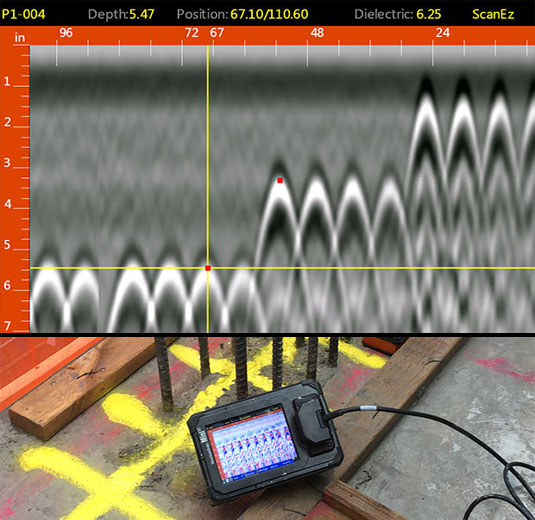Beyond the Surface: Leveraging Advanced Concrete Scanning Techniques for Unmatched Precision and Understanding
Advanced concrete scanning strategies have arised as important devices in this search, using a glimpse underneath the surface area to unveil a globe of important insights. By using advanced modern technologies, professionals can discover abnormalities, examine the condition of concrete structures, and make educated choices that shape the course of projects.
Relevance of Advanced Concrete Scanning
The significance of using innovative concrete scanning strategies lies in the unequaled precision they supply for spotting sub-surface abnormalities and ensuring structural integrity. By utilizing sophisticated modern technologies such as ground-penetrating radar (GPR), electromagnetic induction, and advanced sonar imaging, building experts can dive under the surface of concrete structures with a level of accuracy that much goes beyond typical inspection approaches. Concrete Scanning. These methods allow the identification of surprise dangers like rebar rust, voids, channels, or post-tension cords that can jeopardize the security and security of a framework gradually
In addition, progressed concrete scanning supplies invaluable insights right into the total problem of a concrete aspect without the requirement for invasive steps, decreasing the danger of triggering damage throughout the analysis procedure. The capability to determine the exact area and deepness of possible problems allows for targeted repairs and maintenance, ultimately lengthening the life expectancy of the structure and optimizing its efficiency. Basically, the value of sophisticated concrete scanning can not be overstated in the world of building and infrastructure upkeep, where precision and integrity are extremely important.
Kinds of Cutting-Edge Technologies

Abnormalities and Defect Detection

In addition to GPR, concrete scanning methods like thermography and impact-echo screening are additionally effective in detecting flaws and abnormalities. Thermography uses infrared modern technology to identify variations in surface area temperature, indicating prospective areas of problem such as delamination or moisture ingress. On the other hand, impact-echo testing includes assessing acoustic responses to identify gaps, cracks, and other problems within the concrete. By leveraging these sophisticated methods, specialists can proactively resolve architectural concerns, making sure the durability and security of straight from the source concrete frameworks.
Assessing Concrete Condition
Exactly how can engineers properly review the condition of concrete frameworks to ensure their long life and safety? Assessing the concrete condition is a vital element of maintaining framework honesty. Different innovative concrete scanning methods are utilized for this objective. Ground-penetrating radar (GPR) is commonly made use of to analyze the interior structure of concrete, finding spaces, cracks, and other abnormalities that might jeopardize its stamina. In addition, impact-echo screening can provide insights right into the density and integrity of concrete elements. Ultrasonic pulse rate testing is one more beneficial technique for assessing concrete top quality by determining the speed of acoustic waves through the this content material.
Additionally, visual evaluation remains an essential part of concrete condition evaluation. Engineers aesthetically check out the surface for indications of degeneration, such as spalling, splitting, or staining. Incorporating non-destructive screening methods with visual inspections permits a detailed analysis of concrete problem, enabling designers to identify potential issues beforehand and execute timely maintenance or repair services. By leveraging these sophisticated techniques, designers can make sure the long-term resilience and safety of concrete frameworks.
Enhancing Decision-Making Processes
In the world of infrastructure administration, enhancing decision-making procedures is imperative for making certain the effective maintenance and longevity of concrete frameworks. Improved decision-making procedures in concrete administration entail utilizing advanced scanning strategies to gather thorough information on the problem of frameworks. By leveraging technologies such as ground-penetrating radar and 3D imaging, stakeholders can make informed choices regarding replacement, fixing, or reinforcement techniques.
These progressed scanning techniques give vital insights right into the interior composition of concrete, identifying possible concerns such as spaces, fractures, or rust that may not show up on the surface. This degree of thorough details permits for positive upkeep planning, decreasing the risk of architectural failures and raising the overall lifespan of concrete frameworks.
Moreover, by integrating digital documentation and evaluation devices right into the decision-making procedure, stakeholders can track the development of concrete conditions over time, enabling predictive upkeep methods and optimizing source allotment. Inevitably, the combination of sophisticated concrete scanning techniques improves decision-making procedures by supplying unequaled accuracy, understanding, and efficiency in facilities management.
Verdict
In final thought, advanced concrete scanning strategies provide unmatched precision and insight check in finding abnormalities, flaws, and evaluating the problem of concrete structures. By leveraging advanced innovations, decision-making processes can be enhanced, leading to even more informed and effective options for maintaining and fixing concrete framework. These methods play an essential duty in making sure the safety and durability of concrete structures, making them a vital tool in the area of building and construction and engineering.
In addition, advanced concrete scanning supplies invaluable understandings right into the overall condition of a concrete component without the requirement for invasive procedures, decreasing the danger of creating damages throughout the analysis procedure - Concrete Scanning. Another cutting-edge technology is 3D X-ray scanning, which gives comprehensive photos of the inner structure of concrete, supplying useful info without the demand for harmful screening. Furthermore, Concrete Cover Meters are used to determine the thickness of concrete cover over reinforcement bars accurately. Enhanced decision-making procedures in concrete management include making use of sophisticated scanning methods to gather detailed information on the condition of frameworks.In final thought, progressed concrete scanning methods use exceptional accuracy and understanding in identifying anomalies, problems, and analyzing the condition of concrete frameworks